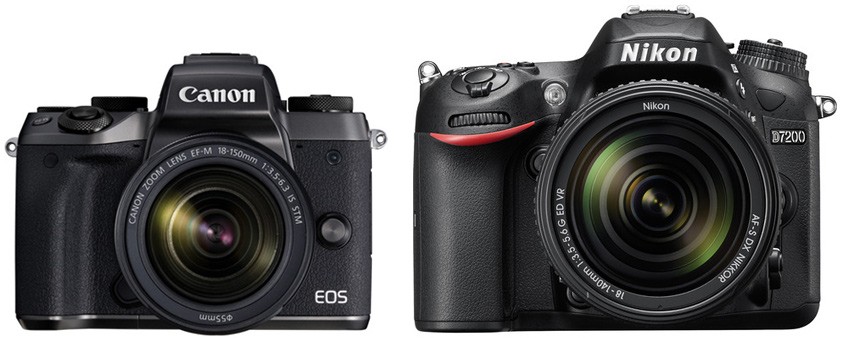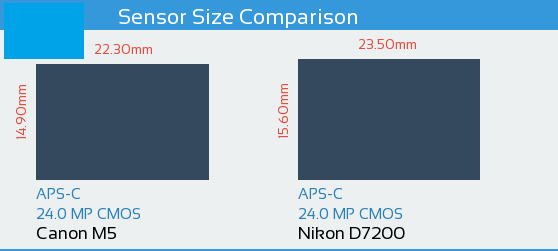Canon M5 vs Nikon D7100
: Two cameras. Two different body types. This article compares Canon’s Semi-Pro Mirrorless camera, the Canon EOS M5, with Nikon’s Semi-Pro DSLR, the Nikon D7200. Both cameras feature a 24.0MP APS-C sensor. To start, here’s a brief overview of the main features of both cameras.
Canon M5 vs Nikon D7200 Specs

Canon M5 vs Nikon D7200
Specifications |
Canon M5 |
Nikon D7200 |
|---|---|---|
| Megapixels | 24.2 | 24.2 |
| Sensor Type | CMOS | CMOS |
| Sensor Format | APS-C | APS-C (DX) |
| Crop Factor | 1.6x | 1.5x |
| AA Filter | Yes | None |
| Image Resolution | 6000 x 4000 | 6000 x 4000 |
| Body Image Stabilization | Yes (Movie only) | No |
| Lens Mount | Canon EF-M | Nikon FX/DX |
| ISO | 100 – 25,600 | 100 – 25,600 |
| Expanded ISO | None | 102,400 (B&W) |
| AF Points | 49 Hybrid | 51 |
| Cross-type AF Points | Dual Pixel AF | 15 |
| Continuous Mode | 7fps | 6fps |
| LCD | 3.2″ – Articulating | 3.2″ – Fixed |
| LCD Resolution | 1,620,000 dots | 1,228,800 dots |
| Touchscreen | Yes | No |
| Focus Peaking | Yes | No |
| Top LCD Display | No | Yes |
| Viewfinder Type | EVF (2.36M) | Optical |
| Viewfinder Coverage | 100% | 100% |
| Viewfinder Magnification | 0.94x | |
| Video Resolution | 1920×1080 (60/50/30/25/24p | 1920×1080 (60/50/30/25/24p |
| 1280×720 (60/50p) | 1280×720 (60/50p) | |
| Microphone Jack | Yes | Yes |
| Headphone Jack | No | Yes |
| Memory Card Type | SD | SD + SD |
| Dual Card Slots | No | Yes |
| SD UHS Support | UHS-I | UHS-I |
| Fastest Shutter Speed | 1/4000 | 1/8000 |
| Slowest Shutter Speed | 30″ | 30″ |
| Bulb Mode | Yes | Yes |
| JPEG Buffer Size | 27 | 56 |
| RAW Buffer Size | 18 | 18 |
| Time Lapse | Yes | Yes |
| Built-in Flash | Yes | Yes |
| Max Flash Sync Speed | 1/200 | 1/250 |
| Startup Time | 1.2s | 0.4s |
| Built-in Wi-Fi | Yes | Yes |
| Built-in GPS | No | No |
| Built-in NFC | Yes | Yes |
| Bluetooth | Yes | No |
| USB Type | USB 2.0 | USB 2.0 |
| Environmentally Sealed | No | Yes |
| Battery Life (CIPA) | 295 shots | 1110 shots |
| Battery Included | Yes (LP-E17) | Yes (EN-EL15) |
| Weight | 15.0 oz (427g) | 23.8 oz (675g) |
| Size | 4.6 x 3.5 x 2.4″ | 5.3 x 4.2 x 3.0″ |
| Price | Amazon | Amazon |
| Release Date | 2016 | 2015 |
Nikon D7200 vs Canon M5 Common Features
| Wireless Connection | Yes vs Yes | Better connectivity |
| Built-in Flash | Yes vs Yes | Useful in low-light |
| External Flash Shoe | Yes vs Yes | Better for flash photography |
| Viewfinder | Yes (Electronic) vs Yes (Optical) | Better framing and control |
| RAW Support | Yes vs Yes | Better image quality |
| Face Detection Focus | Yes vs Yes | very handy for portraits |
| Max Resolution | 24 MP vs 24 MP | Bigger prints and more details |
| LCD Screen Size | 3.2″ vs 3.2″ | Large display |
| Continuous Shooting | 9.0fps vs 6.0fps | Fast shooting speeds |
| Microphone Port | Yes vs Yes | High-quality audio recording option |
| Timelapse Recording | Yes vs Yes | Creative shooting |
| AE Bracketing | Yes vs Yes | Useful for tough lighting conditions and HDR |
| NFC Connection | Yes vs Yes | Easy wireless connectivity with compatible devices |
| Smartphone Remote Control | Yes vs Yes | Remote control your camera with a smartphone |
Canon M5 vs Nikon D7200 Size Comparison
The Canon M5 is definitely the smaller of the two cameras. Its body is 20mm narrower, 18mm shorter and 15mm thinner than Nikon D7200. Furthermore, the Canon M5 is noticeably lighter (338g ) than the Nikon D7200. The M5 is easier to carry around than the D7200.

Canon M5 vs Nikon D7200
Moreover, both cameras have an APS-C sensor. Hence, the lenses they use are practically the same. So, when factoring in the weight, this is not an issue.
Canon M5 vs Nikon D7200 Sensor Comparison
Both the Canon M5 and Nikon D7200 have APS-C sized 24.0 MP resolution sensors so sensor size and resolution are the same between the two cameras.
However, it is worth mentioning that the Nikon D7200’s sensor lacks anti-alias (Low-Pass) filter. This increases the sharpness and level of detail however it also increases the chance of a ripple effect in certain pictures.

Canon M5 vs Nikon D7200 Sensor Comparison
As both the Nikon D7200 and Canon M5 have the same sensor sizes, they provide a good level of control over the depth of field when used with same focal length and aperture. However, the Nikon D7200 has a 1.1x larger sensor area than Canon M5. Larger sensors give you more control over the depth of field and blurry background compared to the smaller sensor when shot in same focal length and aperture.
Canon M5 Advantages Over Nikon D7200
| Wireless Connection | Yes vs Yes | Better connectivity |
| Built-in Flash | Yes vs Yes | Useful in low-light |
| External Flash Shoe | Yes vs Yes | Better for flash photography |
| Viewfinder | Yes (Electronic) vs Yes (Optical) | Better framing and control |
| RAW Support | Yes vs Yes | Better image quality |
| Face Detection Focus | Yes vs Yes | Very handy for portraits |
| Max Resolution | 24 MP vs 24 MP | Bigger prints and more details |
| LCD Screen Size | 3.2″ vs 3.2″ | Large display |
| Continuous Shooting | 9.0fps vs 6.0fps | Fast shooting speeds |
| Microphone Port | Yes vs Yes | High-quality audio recording option |
| Timelapse Recording | Yes vs Yes | Creative shooting |
| AE Bracketing | Yes vs Yes | Useful for tough lighting conditions and HDR |
| NFC Connection | Yes vs Yes | Easy wireless connectivity with compatible devices |
| Smartphone Remote Control | Yes vs Yes | Remote control your camera with a smartphone |
Key reasons that might sway you to choose the Canon M5 over the Nikon D7200:
- Body Image Stabilization – It has body image stabilization but it only works in video.
- Continuous mode – 7fps vs 6fps. It’s an advantage, but not something you will really notice that often.
- LCD – It’s articulated.
- LCD Resolution – Higher resolution.
- Touchscreen Support
- Focus Peaking – Very useful for seeing if your subject is in focus (both photo and video).
- Bluetooth Support
- Weight – The Canon M5 weighs 248g less.
- Size – The Canon M5 is noticeably smaller.
Video: Canon M5 Hands-on Review
Canon’s latest mirrorless camera promises to be an 80D in a smaller package. With 1080p and a reasonable 24-megapixels, is it another flop or does the Dual Pixel Autofocus save the day? Watch as Kai takes you through the pros and cons.
Nikon D7200 Advantages Over Canon M5
| Number of Focus Points | 51 vs 49 | 2 more focus points |
| Max Shutter Speed | 1/8000s vs 1/4000s | Faster shutter speed |
| Battery Life | 1110 shots vs 295 shots | 815 more frames with a single charge |
| Headphone Port | Yes vs No | Better video control |
| Environmental Sealing | Yes vs No | Shoot at tough conditions |
| Flash Coverage | 12.0m vs 5.0m | 7m longer range |
| Sensor Pixel Area | 15.28µm2 vs 13.84µm2 | 10% larger pixel area |
| Top LCD | Yes vs No | Helps with viewing and changing settings easily |
| AE Bracketing Range | ±5 EV vs ±3 EV | Wide Bracketing range is useful for HDR |
| Storage Slot | 2 vs 1 | Extra storage slot |
| Autofocus at f/8 aperture | Center point vs none | Autofocus with teleconverters |
You may want to choose the Nikon D7200 over the Canon EOS M5 because:
- AA Filter – The Nikon D7200 has no AA filter.
- ISO – 102,400 vs 25,600. Higher maximum ISO sensitivity.
- AF Points – 51 vs 49.
- Top LCD Display – When shooting in semi-auto/manual modes, you can quickly preview all of your settings.
- Headphone Jack – Useful for previewing your audio quality straight out the camera.
- Dual Card Slots – More room for extra photos, or simply for backup.
- Faster Max Shutter Speed – 1/8000 vs 1/4000.
- JPEG Buffer Size – 56 vs 27. Useful for long bursts.
- Max Flash Sync Speed – 1/250 vs /200.
- Environmentally Sealed – The Nikon D7200 is good for shooting outdoors in difficult terrain and bad weather conditions.
- Battery Life – 1110 shots vs 295 shots.